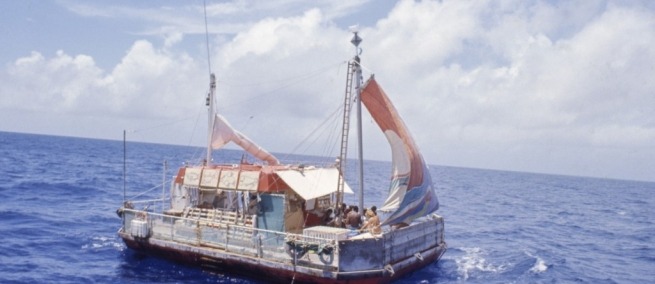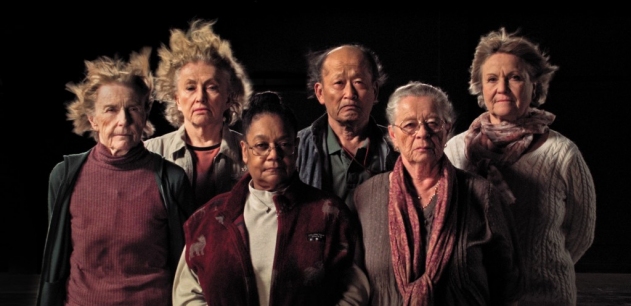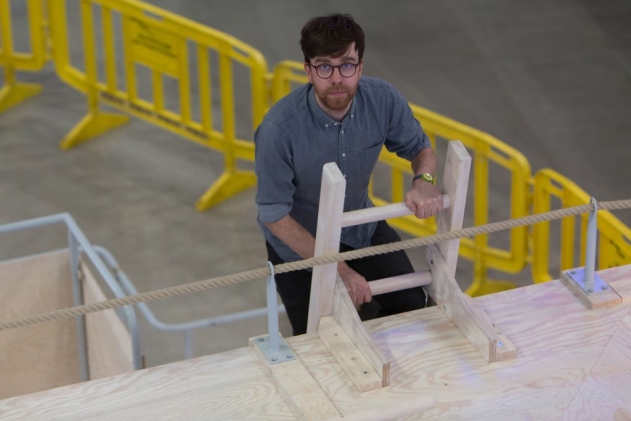
In 1973, a Mexican anthropologist named Santiago Genovés decided that the best way to study the roots of violent behavior and sexual attraction was to set sail for over three months with a group of strangers on a raft where he could observe their interactions. Six women and five men sailed from Spain to Mexico on the Acali. Forty years later, Swedish documentarian Marcus Lindeen reunited the surviving participants. His new film THE RAFT combines studio footage of the participants—five of the remaining six are women—on a replica of the Acali that Lindeen built, with archival footage of the well-documented journey. THE RAFT made its world premiere at CPH: DOX in 2018 where it won the DOX: AWARD. It is now being distributed by Metrograph Pictures. We spoke with Lindeen on June 7 at the Ludlow Hotel in lower Manhattan the day of the New York premiere.
Science & Film: How did you learn about the Acali and this experiment?
Marcus Lindeen: I made one documentary project in a studio environment with two people, called REGRETTERS, and the experience of doing that was fascinating because I felt there was so much to be explored with documentary subjects in this kind of studio setting where I could stage things and control the environment—quite the opposite from being the observational documentarian. So I was quite curious to see what I could do within the studio and I wanted to explore it with more characters and to build a set design to see what would happen. I had an idea that I would like to make a reunion of some older people who had made something radical when they were young. A lot of time had to have passed so you would feel like there was some drama to looking back. So I was looking at several different things from the ’70s: radical queer communes, political theater groups, and a genre on Broadway called the sex musical. Then I stumbled upon this book about the weirdest science experiments of all time and this was one of them. The thing that drew me to it was that it’s an incredible adventure story.
S&F: It’s pretty rare as a science experiment, too. Experiments are generally in very controlled settings.
ML: Exactly! I was so happy that it was a scientific project versus a political one because it wasn’t about ideology; it wasn’t political in the ways that we maybe imagine the radical ’70s to be. It was about understanding general things about humanity: what is the essence of our behavior? Why are we violent? How does sexuality work? I thought that was just perfect, who doesn’t want to explore that? That’s what you want to understand with your life and your art. It almost leant itself to mythology. You could of course see [the Acali] as a failure because we don’t remember this experiment as something that was as important as we do with other social experiments from the ’70s, like the Milgram and Stanford Prison experiments. But the questions it posed we are still interested in, even though the method he used wasn’t maybe the right one.
From what I understand, social anthropology was much wilder in the ’60s and ’70s and was questioned after that in terms of ethical issues and validity. Is it possible to repeat these experiments? To give Santiago some credit, he was an intelligent man. He was very reflective. He had a parallel practice as a poet. He was a thinker, and a visionary one. He wrote that he wanted science to be more like art. He felt like an experiment should be like an abstract painting: it should be daring to throw itself out there and be wild. In a way, that’s really radical and quite appealing, to throw yourself into the unknown and see what happens. That’s quite romantic. But maybe science wasn’t the best realm for that. It maybe would have been a better art project or something.

S&F: Well that’s sort of how you took it!
ML: That’s my homage to him, to try to turn his science into art somehow—to see if art is maybe a better way of playing around with those questions and trying achieve some kind of result than science.
S&F: While making the film, I’m wondering if you as a director felt any resonances with Santiago’s position relative to the members of the raft?
ML: The thing is that in the beginning I was quite naïve; I was thinking, I’m the feminist, Swedish documentary filmmaker who is obviously standing on the women’s side against this misogynist alpha-male character. And then—it was so weird—I was in the studio and we were shooting a scene where all the women were around the table and one of them started to joke with me because I was prompting them with questions. She was making a joke, now I think you’re pushing it a bit just like Santiago would have done. And I was like, really? What? And she said, you’re acting a little bit like Santiago number two, aren’t you? And people were laughing. And I was thinking afterwards, shit, she’s right. Look at me, I have built a raft, just like him. I have been finding money for this crazy experiment which in this case was trying to make this film which cost a lot of money and I imagine he would have done the same thing as a scientist, trying to make this very expensive expedition happen and people questioned him. I had gathered people from all over the world, just like him, and invited them to board this raft just like he did. And just like he, 40 years earlier, had wanted things to happen between them, I wanted things to happen for my film. I was just like, I’m him. It was such a shock to me. Of course, the dynamics are exactly the same. I mean, the women could leave the studio, but the dynamics were there. Hopefully I was a better listener than he was, I tried to facilitate things that would maybe be more beneficial for them as a group so that was different, but still there was something similar and this pushed me in the editing into some kind of crisis with the film wondering, what is the movie about? I realized that maybe I need to understand how the movie is also about me as a filmmaker. Then I realized that I need to give Santiago a voice. Before, I thought maybe I don’t need to because the women will talk about the story. But then I thought he needed to have a voice and to understand his own fall and how he is polluting his experiment. So I hired an actor and wrote a narration from Santiago’s diaries and gave him a voice in the film. My own relation to Santiago became more important than I anticipated and shaped the film a lot.
Santiago published two books about the experiment, one more scientific and another more popular. In the popular book he mixes scientific writing and essayist writing with these sections he calls meditations where he goes on the roof of the raft and meditates thinking about spiritual things. In that sense, I kind of admire him because he tried to have poetry and spiritual aspects enter into science. But I think ego and hubris overcame him. He wanted to become a famous scientist. He had been part of two science expeditions on rafts before with a Norwegian explorer called Thor Heyerdahl, who is the man behind Kon-Tiki, so that’s how he came up with the idea that a raft is the perfect floating laboratory to study human behavior. But he wanted to do it with men and women and see what happens between people. I think he really wanted to become as famous as Heyerdahl in the scientific world.

S&F: So as much as he wanted the experiment to be uncontrolled, he wanted it to go a certain way so that it would reflect well on him.
ML: Of course. And that’s similar to being an artist and making a movie: you want it to be recognized and be successful, obviously that’s one driving force.
S&F: Have you shown the film in Mexico?
ML: Yeah, we showed it in a really good film festival called Ficunam in March and we’re having Mexican cinema distribution starting in the fall. We actually re-recorded the actor speaking in Spanish because I felt that for a Spanish-speaking audience it would be weird to hear Santiago speak English.
S&F: Is he better known there?
ML: Totally. He was a known figure in Mexico. People from his generation remember the project.
S&F: Has his family seen your film?
ML: His family was all there for the first screening. I was worried about how they would feel about the film because I think I’m being respectful towards him but he does kind of fall. But his son is so sweet and generous and he’s been that with me the whole time, both before and after seeing the film, and he says that his father was a very complex character. So I think he feels that it’s fine, that’s how Santiago was. And I think Santiago learns something about himself. He realizes that he ruined it.

Marcus Lindeen
THE RAFT is now playing at Metrograph in Manhattan and will have a nationwide release. It is written and directed by Marcus Lindeen, produced by Erik Gandini, and edited by Dominika Daubenbüchel and Alexandra Strauss. The film has won top awards at CPH: DOX, the Athens International Film Festival, the Chicago International Film Festival, and the RiverRun International Film Festival.
TOPICS